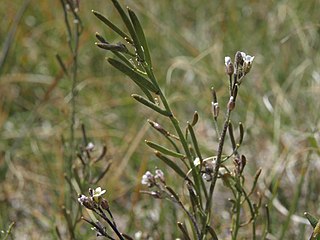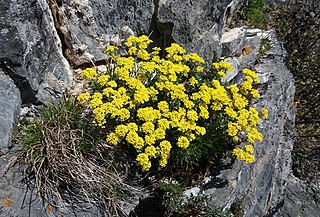
Matthiola is a genus of flowering plant in the mustard family Brassicaceae. It is named after Italian naturalist Pietro Andrea Mattioli (1501–1577). The genus contains about 50 species of annual, biennial and perennial herbaceous plants and subshrubs. Many are cultivated for their heavily scented, colorful flowers.

Cardamine is a large genus of flowering plants in the mustard family, Brassicaceae, known as bittercresses and toothworts. It contains more than 200 species of annuals and perennials. Species in this genus can be found in diverse habitats worldwide, except the Antarctic. The name Cardamine is derived from the Greek kardaminē, water cress, from kardamon, pepper grass.

Polygonum is a genus of about 130 species of flowering plants in the buckwheat and knotweed family Polygonaceae. Common names include knotweed and knotgrass. In the Middle English glossary of herbs Alphita, it was known as ars-smerte. There have been various opinions about how broadly the genus should be defined. For example, buckwheat has sometimes been included in the genus as Polygonum fagopyrum. Former genera such as Polygonella have been subsumed into Polygonum; other genera have been split off.

Isatis is a genus of flowering plants in the family Brassicaceae, native to the Mediterranean region east to central Asia. Its genus name, Isatis, derives from the ancient Greek word for the plant, ἰσάτις. The genus includes woad. Due to their extremely variable morphology, the Asian species in particular are difficult to determine; the only reliable diagnostic feature is the ripe fruit. They are (usually) biennial or perennial herbaceous plants, often bluish and hairless or downy hairy with the upright stem branched.

Draba is a large genus of flowering plants in the family Brassicaceae, commonly known as whitlow-grasses.

Chorispora is a genus of plant in the family Brassicaceae.

Solms-laubachia is a high-altitude genus of perennial herbs in the family Brassicaceae. It is named for the German botanist Hermann zu Solms-Laubach.

Parrya is a genus of flowering plants in the family Brassicaceae, found in the arctic and subarctic biomes of the Northern Hemisphere, and in Central Asia. The center of diversity is the Tian Shan and Pamir-Alay mountain ranges.

Eutrema is a genus of flowering plants of the family Brassicaceae, native to the Holarctic. Its best known member is wasabi, Eutrema japonicum. The name comes from the Greek εὐ- (eu-) 'well' et τρῆμα (trêma) 'hole', because of a hole in the septum of the fruit.

Noccaea is a problematic genus of flowering plants in the family Brassicaceae, native to temperate areas of western North America, southern South America, northern Africa, Europe and Asia.

Polypsecadium is a genus of large herbaceous species of plants in the family Brassicaceae, found growing in South America. Most of the species were formerly classified in the genus Sisymbrium.
Aphragmus is a genus of flowering plants belonging to the family Brassicaceae.

Crucihimalaya is a genus of flowering plants belonging to the family Brassicaceae.
Menonvillea is a genus of flowering plants belonging to the family Brassicaceae.
Olimarabidopsis is a genus of flowering plants belonging to the family Brassicaceae.
Dontostemon is a genus of flowering plants belonging to the family Brassicaceae.
Romanschulzia is a genus of flowering plants belonging to the family Brassicaceae.

Odontarrhena is a large genus of flowering plants in the family Brassicaceae. They were originally a separate genus and then were amalgamated into the Alyssum genus, but then morphological and molecular evidence has reseperated them. Some of the genera are nickel (Ni) hyperaccumulators.














